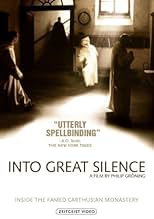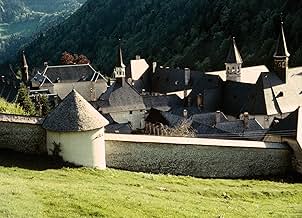IMDb RATING
7.3/10
2.6K
YOUR RATING
An examination of life inside the Grande Chartreuse, the head monastery of the reclusive Carthusian Order in France.An examination of life inside the Grande Chartreuse, the head monastery of the reclusive Carthusian Order in France.An examination of life inside the Grande Chartreuse, the head monastery of the reclusive Carthusian Order in France.
- Director
- Writer
- Awards
- 5 wins & 14 nominations total
Featured reviews
If you want to see the contemplative, Roman Catholic view of Christ's teachings, this is for your. If you want to see a truly natural and realistic movie without artificial lighting (except the electric lights already at the monastery) this is for you. This movie is an absolute must for people who want to see what can been done just by taking a camera into the field and shooting. The message is simple and repeated over and over again because the contemplative life is simple and they spend their days trying to "grasp that which cannot be grasped": "Grace" and God. This movie is a must for those who think that Catholicism is too mystical. It clearly describes the simple beliefs of the contemplative life: that as one abandons one's attachments to things and the material world, one is seduced into the nirvana of religious enlightenment. During the final scene with the blind monk, an interesting comment is made on body sculpting, plastic surgery and other techniques that make one appear younger than one is. Incidentally, a Hindu or Buddhist would find the Christian view of nirvana described in this movie very interesting and the contemplative Christian path astonishingly similar to the contemplative Hindu and Buddhist paths.
10enorvind
A sensitive and deeply moving film. We follow the life in silence of the monks in the Grande Chartreuse Monastery in the French Alps. Only once a week are the monks aloud to talk when they go for a walk in the woods or glide in the snow during winter. The photography is magnificent as the camera respectfully observes the monks quiet life of prayer and daily tasks. At certain intervals we see close-up of the monks whose faces impact us by simply being present. During two hours we become part of the monastery, the routines and the beauty of the mountains that surround us. After seeing fifty films at the Sundance Film Festival, this is the film that has stayed with me. The filmmaker waited 16 years before he got permission to shoot in the monastery and it was well worth waiting.
If you begin watching this film expecting an explanatory documentary about monastic life in La Grande Chartreuse, you may soon become bored and fed up. If you begin watching this film expecting to be taken into the monastic way of life, you will soon find yourself there. The movie takes the pace of the slow, quiet atmosphere of the monastery. Long periods of silence broken by the occasional creak of floorboards or chanting or bells, and very little dialogue. It is like each shot is a photograph. A moving photograph.
It is not entirely what one expects, however. Keep an eye out for the odd object seemingly out of place: the highlighter, the keyboard, the laptop; the odd conversation on a monk's departure for Seoul, South Korea; the shot of monks sliding down a snowy bank on their bums.
I wanted more explanation - how the individuals chose this way of life; how they sustain their community; what contact they have with secular people. But it is not that kind of documentary. As long as you're prepared for that, it is a film worth watching.
It is not entirely what one expects, however. Keep an eye out for the odd object seemingly out of place: the highlighter, the keyboard, the laptop; the odd conversation on a monk's departure for Seoul, South Korea; the shot of monks sliding down a snowy bank on their bums.
I wanted more explanation - how the individuals chose this way of life; how they sustain their community; what contact they have with secular people. But it is not that kind of documentary. As long as you're prepared for that, it is a film worth watching.
This almost silent three hour documentary tracks the daily lives of Carthusian monks living at the Chartreuse Monastery in the French Alps, as they live in a way that seems to be in such contrast with the modern world. It's a fascinating movie if you are able to get into the slow rhythm of the film (if you are still in the movie theater after an hour, you will probably made it to the third hour). By the same token, it would be almost impossible to see it in your house on DVD, since there are so many possible distractions that would make you want to stop the film. Remarkably, given that European filmmakers tend to be among the most secular people in the world, the movie is also surprisingly respectful of the choices made by the monks in living in this particular way.
In 1984, novice filmmaker Philip Gröning asked the Carthusian monks of the Grand Chartreuse if he could film them. They said it was too soon, and thus, 16 years later, Gröning received a call: they were ready. A sublime mix of transcendence and cinéma vérité, the result, Into Great Silence, is a masterful trip inside the monastery, a 162 minute voyage that spellbinds, entrances, and makes you become one with the film itself.
Filming by himself on hi-definition video and Super 8 for only a few hours a day, using only available light and sound, Gröning was required to live and work among the monks, both observing them and becoming one with them. He structures the film in an unscathed and natural way, both accurately capturing the monks' daily routines yet also flowing by seasons. Each season has its own pleasures, which range from the playful walks of the monks in spring and summer to the moody yet harmonious mise-en-scene of the winter. Sublime to its very hushed core, Into Great Silence does take some getting used to, specifically because the monks hardly utter a word; the beginning of the film is a four minute opening shot of a monk praying in his solitary room. It is after this, however, that the film resembles true life itself: rarely have documentaries portrayed such an unhurried sense of time, yet all of the film passes faster than you wish it to, each minute counting to the very last.
Gröning's masterful shots of the Grand Chartreuse are let alone one reason that elates the film, yet more than a placed and planned camera, the shots almost resemble spying. It is undeniably true, as weird as it may sound, that the monks have gotten used to the camera. Months go on, and they blatantly ignore it, which only goes for the better. In what follows, Gröning takes us through more than just the random praying of the monks, but also of them playing (there's a scene of the monks going sledding), cooking, eating and sewing, all daily activities of the monks (excluding the playing aspect.) One need not be religious, or even agree with the existence of god and the fact of locking oneself in a monastery, to enjoy a film of this caliber. Nevertheless, Gröning has created a film of its kind: the type that will keep you thinking and enjoying its quiet pleasuresonly through simple imagesfor a long time, yet also one that could gratify film lovers without a limit to its quiet sense of aptness.
Filming by himself on hi-definition video and Super 8 for only a few hours a day, using only available light and sound, Gröning was required to live and work among the monks, both observing them and becoming one with them. He structures the film in an unscathed and natural way, both accurately capturing the monks' daily routines yet also flowing by seasons. Each season has its own pleasures, which range from the playful walks of the monks in spring and summer to the moody yet harmonious mise-en-scene of the winter. Sublime to its very hushed core, Into Great Silence does take some getting used to, specifically because the monks hardly utter a word; the beginning of the film is a four minute opening shot of a monk praying in his solitary room. It is after this, however, that the film resembles true life itself: rarely have documentaries portrayed such an unhurried sense of time, yet all of the film passes faster than you wish it to, each minute counting to the very last.
Gröning's masterful shots of the Grand Chartreuse are let alone one reason that elates the film, yet more than a placed and planned camera, the shots almost resemble spying. It is undeniably true, as weird as it may sound, that the monks have gotten used to the camera. Months go on, and they blatantly ignore it, which only goes for the better. In what follows, Gröning takes us through more than just the random praying of the monks, but also of them playing (there's a scene of the monks going sledding), cooking, eating and sewing, all daily activities of the monks (excluding the playing aspect.) One need not be religious, or even agree with the existence of god and the fact of locking oneself in a monastery, to enjoy a film of this caliber. Nevertheless, Gröning has created a film of its kind: the type that will keep you thinking and enjoying its quiet pleasuresonly through simple imagesfor a long time, yet also one that could gratify film lovers without a limit to its quiet sense of aptness.
Did you know
- TriviaPhilip Groning (director) spent six months living in the Grande Chartreuse Monastery with the Carthusian monks. Normally, the order doesn't allow visitors within the enclosure, but after thinking, discussing, and praying about it for sixteen years, they finally agreed to allow him to make his film. Groning shot all the footage on his own, and decided early on to use no special effects: no soundtrack (other than the Carthusian chants), no artificial sound effects, no commentary, not even any artificial lighting. The only inclusion to the natural rhythm of the monastery was a modest collection of intertitular scriptures. After two-and-a-half years of editing, Groning presented his completed film. Reportedly, the monks saw the documentary and thoroughly enjoyed it.
- Quotes
Blind Monk: The past, the present, these are human. In God there is no past. Solely the present prevails. And when God sees us, He always sees our entire life. And because He is an infinitely good being, He eternally seeks our well-being. Therefore there is no cause for worry in any of the things which happen to us.
- ConnectionsFeatured in Het elfde uur: Episode #15.4 (2006)
- How long is Into Great Silence?Powered by Alexa
Details
- Release date
- Countries of origin
- Official sites
- Languages
- Also known as
- El gran silencio
- Filming locations
- Production companies
- See more company credits at IMDbPro
Box office
- Gross US & Canada
- $790,452
- Opening weekend US & Canada
- $11,355
- Mar 4, 2007
- Gross worldwide
- $4,886,163
- Runtime
- 2h 49m(169 min)
- Color
- Sound mix
- Aspect ratio
- 1.85 : 1
Contribute to this page
Suggest an edit or add missing content














